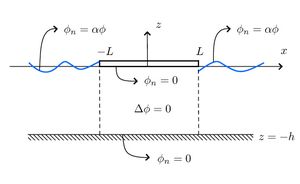Difference between revisions of "Green Function Method for a Finite Dock"
| Line 10: | Line 10: | ||
{{finite dock equations}} | {{finite dock equations}} | ||
| − | |||
| − | |||
| − | |||
| − | |||
| − | |||
| − | |||
| − | |||
| − | |||
| − | |||
| − | |||
| − | |||
== Equation in Terms of the Modes of the Plate == | == Equation in Terms of the Modes of the Plate == | ||
Revision as of 00:04, 17 September 2009
Introduction
The problem of a two-dimensional finite dock is solved using a green function. The same problem is solved using eigenfunction matching in Eigenfunction Matching for a Finite Dock.
Equations for a Dock in the Frequency Domain
We consider here the Frequency Domain Problem for a finite dock which occupies the region [math]\displaystyle{ -L\lt x\lt L }[/math] (we assume [math]\displaystyle{ e^{i\omega t} }[/math] time dependence). The water is assumed to have constant finite depth [math]\displaystyle{ h }[/math] and the [math]\displaystyle{ z }[/math]-direction points vertically upward with the water surface at [math]\displaystyle{ z=0 }[/math] and the sea floor at [math]\displaystyle{ z=-h }[/math]. The boundary value problem can therefore be expressed as
[math]\displaystyle{ \Delta\phi=0, \,\, -h\lt z\lt 0, }[/math]
[math]\displaystyle{ \phi_{z}=0, \,\, z=-h, }[/math]
[math]\displaystyle{ \partial_z\phi=0, \,\, z=0,\,-L\lt x\lt L, }[/math]
We must also apply the Sommerfeld Radiation Condition as [math]\displaystyle{ |x|\rightarrow\infty }[/math]. This essentially implies that the only wave at infinity is propagating away and at negative infinity there is a unit incident wave and a wave propagating away.
Equation in Terms of the Modes of the Plate
Under these assumptions, the equations become
We solve for the potential (and displacement) as the sum of the diffracted and radiation potentials in the standard way, as for a rigid body.
We begin with the diffraction potential [math]\displaystyle{ \phi^{\mathrm{D}} }[/math] which satisfies the following equations
Furthermore, [math]\displaystyle{ \phi^{\mathrm{D}} }[/math] satisfies the Sommerfeld Radiation Condition
where [math]\displaystyle{ k ,\, }[/math] is the wavenumber, which is the positive real solution of the Dispersion Relation for a Free Surface
and [math]\displaystyle{ \phi^{\rm I} }[/math] is the incident wave given by
(which has unit amplitude in potential) and is travelling towards positive infinity.
As the plate is floating on the surface, we can denote it as follows:
We now consider the scattered potentials [math]\displaystyle{ \phi^{\mathrm{S}} }[/math]. The relationship between scattered potentials, diffracted potentials and the incident wave are as follows:
from this, we can construct the following conditions:
We now consider the radiation potentials [math]\displaystyle{ \phi^{\mathrm{R}} }[/math]. We can express the radiation potential as:
which satisfy the following equations
The radiation condition for the radiation potential is
Therefore we find the potential as
so that
If we multiply by [math]\displaystyle{ X_m }[/math] and take an inner product over the plate we obtain
where the functions [math]\displaystyle{ a_{mn}(\omega) }[/math] and [math]\displaystyle{ b_{mn}(\omega) }[/math] are given by
and they are referred to as the added mass and damping coefficients (see Added-Mass, Damping Coefficients And Exciting Forces for the equivalent definition for a rigid body). respectively. This equation is solved by truncating the number of modes.
Solution for the Radiation and Diffracted Potential
We use the Free-Surface Green Function for two-dimensional waves, with singularity at the water surface since we are only interested in its value at [math]\displaystyle{ z=0. }[/math] Using this we can transform the system of equations to
and
Details about this method can be found in Integral Equation for the Finite Depth Green Function at Surface.
Reflection and Transmission Coefficients
The Reflection and Transmission Coefficients represent the ratio of the amplitude of the reflected or transmitted wave to the amplitude of the incident wave. They hold the property that [math]\displaystyle{ |R|^2+|T|^2=1\, }[/math] (and may often contain an imaginery element).

We can calculate the Reflection and Transmission coefficients as follows: Applying Green's theorem to [math]\displaystyle{ \phi\, }[/math] and [math]\displaystyle{ \phi^{\mathrm{I}}\, }[/math] gives:
<br\>
where [math]\displaystyle{ k_0 \, }[/math] is the first imaginery root of the dispersion equation and the incident wave is of the form: [math]\displaystyle{ \phi^I=\phi_0(z)e^{-ikx} \, }[/math]<br\><br\> Therefore, in the case of a floating plate (where z=0):
and using a wave incident from the right we obtain
Matlab Code
A program to calculate the solution in elastic modes can be found here A program to calculate the solution in elastic modes can be found here
Additional code
This program requires
Additional code
This program requires
Alternative Solution Method using Green Functions for a Uniform Plate
We can also solve the equation by a closely related method which was given in Meylan and Squire 1994. We can transform the equations to
Expanding as before
[math]\displaystyle{ \partial_z \phi = i\omega \sum \xi_n X_n }[/math]
we obtain
This leads to the following equation
[math]\displaystyle{ \partial_z\phi(x) = \frac{1}{\alpha} \int_{-L}^{L} \frac{X_n(x)X_n(\xi)}{\beta\lambda_n^4 - \gamma\alpha + 1} \phi(\xi)\mathrm{d}\xi }[/math]
or
[math]\displaystyle{ \partial_z\phi(x) = \frac{1}{\alpha} \int_{-L}^{L} g(x,\xi) \phi(\xi)\mathrm{d}\xi }[/math]
where
[math]\displaystyle{ g(x,\xi) = \frac{X_n(x)X_n(\xi)}{\beta\lambda_n^4 - \gamma\alpha + 1} }[/math]
which is the Green function for the plate.
